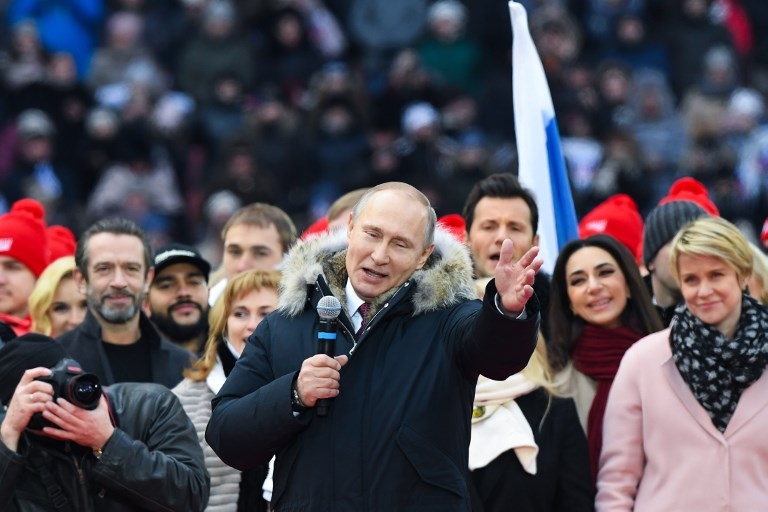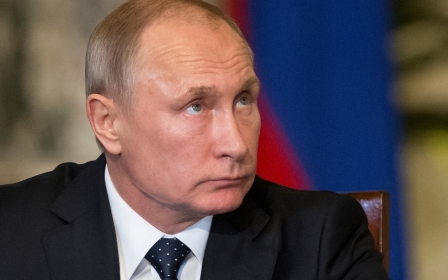Putin's missile diplomacy: Rocket man flexes muscles over Syria

As the country's election approaches on 18 March, Russia on Sunday test-fired a hypersonic missile, which was among the types President Vladimir Putin described in his annual state of the nation address on 1 March. The speech and the missile launch are an attempt to encourage significant voter turnout in a rather uncontested race.
Two-thirds of the way through, the speech turned from the state of Russia’s economy to a bellicose declaration of the nation’s new advances in ballistic missile technology. Startled observers heralded the speech as a renewal of Cold War rhetoric and a new arms race.
A trio of rocket men
While the speech was cryptically targeted at the US, it was primarily addressed to a domestic audience, aiming to deflect attention from the deaths of Russian mercenaries in eastern Syria as a result of American air strikes on February 7-8.
Syria had already become a testing ground for Russian missiles as early as 2015, setting a precedent of cloaked threats to the US and NATO before Putin’s speech. While Putin’s missile tests and speech harken back to the geopolitical games of deterrence from the Cold War era, it is in fact just the latest episode in a militarised diplomatic Russian-American confrontation in Syria, where the war will enter its eighth year this month.
Boasting and threatening about ballistic missiles was Putin’s most recent attempt to bolster Russia’s posture in Syria and his own position on the eve of Russia’s elections
Putin did not hold his state of the nation speech in the usual venue, the Kremlin’s gilded St George Hall, but in the more modern Manezh auditorium, which can accommodate massive video screens. The reason for this move became apparent two hours into the speech, when it shifted from the country’s economic future to a video demonstration of Russia’s new missiles.
The speech invoked US President Donald Trump’s speech before the United Nations in September, when he branded North Korean leader Kim Jong-un as “Rocket Man”, a term borrowed from an Elton John song. However, Trump would also qualify as a rocket man. After all, Putin’s speech was delivered after the US in February released a new nuclear arms policy implementing Trump’s promise to develop an arsenal “so strong and powerful that it will deter any acts of aggression”.
Essentially, Trump, Putin and Kim are all rocket men. They all use “rockets”, or more specifically cruise and ballistic missiles, to send political messages to their rivals. A live missile test, or even CGI video footage showing the potential threat, sends a symbolic message to rivals – a form of “missile diplomacy”.
A de facto response to US strike
On the surface, there is nothing per se that connects Putin’s speech to Syria. However, it does come in the aftermath of both the new US nuclear posture and the deaths of the Russians employed by Evro Polis, a company often referred to as “Wagner”.
A skirmish began outside the city of Deir Ezzor between Wagner and its allied Syrian militias against the Kurdish-led Syrian Democratic Forces (SDF). US air support came to the SDF’s aid. Estimates of how many of Wagner’s forces were killed range from 10 to 200.
The Russian government sought to cover up the incident, which would have hurt Putin in the run-up to the elections. With no military means to retaliate against the US, the speech served as a de facto response.
If Putin’s speech was meant to communicate military might, this pattern had its precedent in Syria much earlier. Between fall 2015 and summer 2016, Russia had been testing long-range Kalibr cruise missiles over Syria, ostensibly against Islamic State (IS) targets.
Then, there were Russian planes stationed in Syria, and deploying those aircraft would have been more accurate and effective in targeting IS - not to mention cheaper than costly cruise missiles. But for Putin, an air raid would not have delivered the same political message.
The range of the cruise missiles demonstrated to the US and NATO the advances in Russian military technology, relating to Moscow’s tensions with the US not only over Syria, but also over Ukraine and NATO’s presence in the Baltic states.
Syria as a live-action Russian arms expo
Like the videos designed to appeal to a domestic audience during Putin’s speech, the missiles in the 2015 attacks were documented by Russia’s defence ministry on YouTube, giving citizens a chance to “like” the nation’s arsenal - a form of post-modern missile nationalism. The 2015 video garnered more than seven million views.
Beyond missile advances, Russia has also been demonstrating the capabilities of its first stealth fighter, the Su-57, deployed to Syria for combat testing in late February - another calculated response to the Deir Ezzor deaths.
Syria’s conflict, as it enters year eight, has become a live-action Russian arms expo.
15 March 2011 is considered the start date of Syria’s civil war, after protests erupted over the detentions and deaths of Syrian youths who spray-painted anti-government slogans. Ironically, in the vein of Putin’s speech, Syrian President Bashar al-Assad gave of a state of the nation speech on 30 March 2011 that could have de-escalated the conflict, but rather emboldened opposition after failing to make any conciliatory reforms.
Since then, the Syrian civil war has evolved into a proxy arena: Iran versus Saudi Arabia/Israel, and Russia versus the US. Boasting and threatening about ballistic missiles was Putin’s most recent attempt to bolster Russia’s posture in Syria and his own position on the eve of Russia’s elections.
As the conflicts between Iran and its rivals, and between the US and Russia, show no signs of abating, this regional and extra-regional dynamic does not bode well for a resolution of the hostilities in Syria this year.
- Ibrahim al-Marashi is Associate Professor of Middle East History at California State University San Marcos. His publications include Iraq's Armed Forces: An Analytical History (2008), The Modern History of Iraq (2017), and A Concise History of the Middle East (forthcoming).
The views expressed in this article belong to the author and do not necessarily reflect the editorial policy of Middle East Eye.
Russian President Vladimir Putin gives a speech during a rally in advance of the upcoming presidential election in Moscow on 3 March 2018 (AFP)
New MEE newsletter: Jerusalem Dispatch
Sign up to get the latest insights and analysis on Israel-Palestine, alongside Turkey Unpacked and other MEE newsletters
Middle East Eye delivers independent and unrivalled coverage and analysis of the Middle East, North Africa and beyond. To learn more about republishing this content and the associated fees, please fill out this form. More about MEE can be found here.






